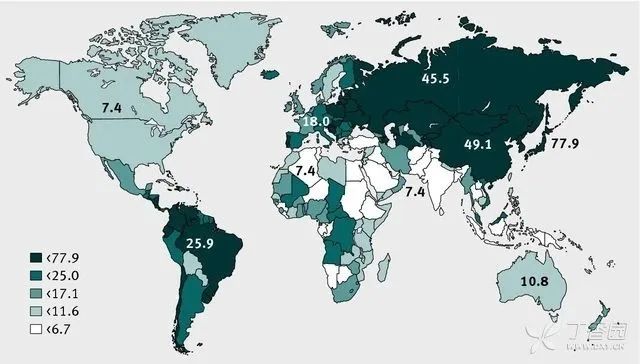Stomach cancer has the highest incidence among all digestive tract tumors worldwide. However, it is a preventable and treatable condition. By leading a healthy lifestyle, undergoing regular check-ups, and seeking early diagnosis and treatment, we can effectively combat this disease. Let us now provide you with clarifications on nine important questions to help you better understand stomach cancer.
1. Does stomach cancer vary by ethnicity, region, and age?
According to the latest global cancer data in 2020, China has reported around 4.57 million new cancer cases, with stomach cancer accounting for approximately 480,000 cases, or 10.8%, ranking among the top three. Stomach cancer shows clear variations in terms of ethnicity and region. The East Asian region is a high-risk area for stomach cancer, with China, Japan, and South Korea accounting for about 70% of the total cases worldwide. This is attributed to factors such as genetic predisposition, the consumption of grilled and pickled foods, and high smoking rates in the region. In mainland China, stomach cancer is prevalent in coastal regions with high-salt diets, as well as the middle and lower reaches of the Yangtze River and relatively impoverished areas.
In terms of age, the average onset of stomach cancer is between 55 and 60 years old. Over the past decade, the incidence rate of stomach cancer in China has remained relatively stable, with a slight increase. However, the rate of occurrence among young people has been rising at a faster rate, surpassing the national average. Additionally, these cases are often diagnosed as diffuse-type stomach cancer, which presents treatment challenges.
2. Does stomach cancer have precancerous lesions? What are the main symptoms?
Gastric polyps, chronic atrophic gastritis, and residual stomach are high-risk factors for stomach cancer. The development of stomach cancer is a multifactorial, multilevel, and multistage process. In the early stages of stomach cancer, patients often do not exhibit obvious symptoms, or they may only experience mild discomfort in the upper abdomen, atypical upper abdominal pain, loss of appetite, bloating, belching, and in some cases, black stool or vomiting blood. When symptoms become more pronounced, indicating the middle to advanced stages of stomach cancer, patients may experience unexplained weight loss, anemia, hypoalbuminemia (low levels of protein in the blood), edema, persistent abdominal pain, vomiting blood, and black stools, among others.
3. How can high-risk individuals for stomach cancer be detected early?
Family history of tumors: If there are cases of digestive system tumors or other tumors in two or three generations of relatives, the likelihood of developing stomach cancer is higher. The recommended approach is to undergo professional tumor screening at least 10-15 years earlier than the youngest age of any family member with cancer. For stomach cancer, a gastroscopy examination should be conducted every three years, as advised by a doctor. For example, if the youngest age of a family member with cancer is 55 years old, the first gastroscopy examination should be performed at the age of 40.
Individuals with a long history of smoking, alcohol consumption, a preference for hot, pickled, and grilled foods, and a high consumption of salted foods should promptly adjust these unhealthy habits, as they can cause significant damage to the stomach.
Patients with gastric ulcers, chronic gastritis, and other gastric diseases should actively seek treatment to prevent disease progression and undergo regular check-ups at the hospital.
4. Can chronic gastritis and gastric ulcers lead to stomach cancer?
Some gastric diseases are high-risk factors for stomach cancer and should be taken seriously. However, having gastric diseases does not necessarily mean that one will develop stomach cancer. Gastric ulcers are clearly associated with an increased risk of developing cancer. Long-term and severe chronic gastritis, especially if it shows signs of atrophy, intestinal metaplasia, or atypical hyperplasia, requires close monitoring. It is important to immediately quit unhealthy habits such as stopping smoking, limit alcohol consumption, and avoid fried and high-salt foods. Additionally, it is advised to have regular annual check-ups with a gastrointestinal specialist to assess the specific situation and consider recommendations such as gastroscopy or medication.
5. Is there a relationship between Helicobacter pylori and gastric cancer?
Helicobacter pylori is a bacteria commonly found in the stomach, and it is associated with a certain type of stomach cancer. If a person tests positive for Helicobacter pylori and also has chronic gastric diseases such as chronic gastritis or gastric ulcers, their risk of developing stomach cancer increases. Seeking timely medical treatment is crucial in such cases. In addition to the affected individual receiving treatment, family members should also undergo screenings and consider synchronized treatment if necessary.
6. Is there a less painful alternative to gastroscopy?
Indeed, undergoing a gastroscopy without pain relief measures can be uncomfortable. However, when it comes to detecting early-stage stomach cancer, gastroscopy is currently the most effective method. Other diagnostic methods may not detect stomach cancer at an early stage, which can greatly impact the chances of successful treatment.
The advantage of gastroscopy is that it allows doctors to directly visualize the stomach by inserting a thin, flexible tube through the esophagus and using a small camera-like probe. This enables them to have a clear view of the stomach and not miss any subtle changes. Early signs of stomach cancer can be very subtle, similar to a small patch on our hand that we might overlook, but there may be slight changes in the color of the stomach lining. While CT scans and contrast agents can identify certain larger gastric abnormalities, they may not capture such subtle changes. Therefore, for those who are recommended to undergo gastroscopy, it is important not to hesitate.
7. What is the gold standard for stomach cancer diagnosis?
Gastroscopy and pathological biopsy are the gold standard for diagnosing stomach cancer. This provides a qualitative diagnosis, followed by staging. Surgery, radiation therapy, chemotherapy, and supportive care are the main treatment modalities for stomach cancer. Surgery is the primary treatment for early-stage stomach cancer, and multidisciplinary comprehensive treatment is currently considered the most advanced treatment approach for stomach cancer. Based on the patient’s physical condition, disease progression, and other factors, a multidisciplinary team of experts collaboratively develops a personalized treatment plan for the patient, which is particularly necessary for patients with complex conditions. If the staging and diagnosis of the patient are clear, treatment can be performed according to the relevant guidelines for stomach cancer.
8. How should one seek medical care for stomach cancer in a scientific manner?
Irregular treatment may stimulate the growth of tumor cells and increase the difficulty of subsequent treatments. The initial diagnosis and treatment are crucial for patients with stomach cancer, so it is important to seek medical care from a specialized oncology department. After a thorough examination, the doctor will evaluate the patient’s condition and provide treatment recommendations, which should then be discussed with the patient and their family members before making a decision. Many patients feel anxious and want an immediate diagnosis today and surgery tomorrow. They can’t wait in line for examinations or for a hospital bed. However, in order to receive prompt treatment, going to non-specialized and non-expert hospitals for irregular treatment can potentially pose risks to the subsequent management of the disease.
When stomach cancer is detected, it has generally been present for a certain period of time. Unless there are severe complications such as perforation, bleeding, or obstruction, there is no need to worry that delaying immediate surgery will accelerate tumor progression. In fact, allowing sufficient time for doctors to thoroughly understand the patient’s condition, assess their physical tolerance, and analyze the characteristics of the tumor is essential for better treatment outcomes.
9. How should we view the statement that “one-third of patients are frightened to death”?
This statement is overly exaggerated. In reality, cancer is not as terrifying as we may imagine. Many people live with cancer and lead fulfilling lives. After a cancer diagnosis, it is important to adjust one’s mindset and engage in positive communication with optimistic patients. For individuals who are in the recovery phase after stomach cancer treatment, family members and colleagues need not treat them as fragile beings, restricting them from doing anything. This approach can make patients feel as though their value is not being recognized.
The cure rate of gastric cancer
The cure rate for stomach cancer in China is approximately 30%, which is not particularly low compared to other types of cancer. For early-stage stomach cancer, the cure rate is generally around 80% to 90%. For stage II, it is generally around 70% to 80%. However, by stage III, which is considered advanced, the cure rate drops to around 30%, and for stage IV, it is less than 10%.
In terms of location, distal stomach cancer has a higher cure rate compared to proximal stomach cancer. Distal stomach cancer refers to cancer located closer to the pylorus, while proximal stomach cancer refers to cancer located closer to the cardia or gastric body. Signet ring cell carcinoma is more difficult to detect and tends to metastasize, resulting in a lower cure rate.
Therefore, it is crucial to pay attention to any changes in one’s body, undergo regular medical check-ups, and seek prompt medical attention if experiencing persistent gastrointestinal discomfort. If necessary, gastroscopy should be performed. Patients who have undergone endoscopic treatment in the past should also have regular follow-up appointments with a gastrointestinal specialist and adhere to medical advice for periodic gastroscopy examinations.
Post time: Aug-10-2023


